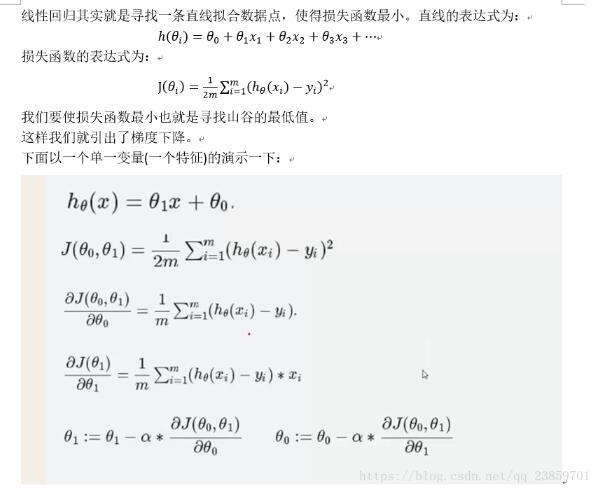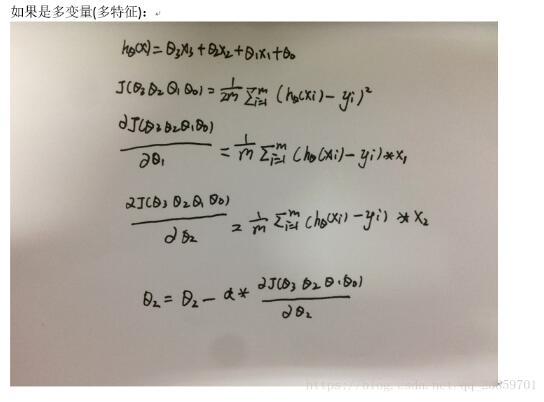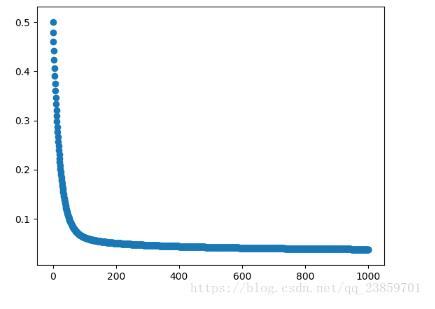python使用梯度下降算法实现一个多线性回归,供大家参考,具体内容如下
图示:


import pandas as pd import matplotlib.pylab as plt import numpy as np # Read data from csv pga = pd.read_csv("D:\python3\data\Test.csv") # Normalize the data 归一化值 (x - mean) / (std) pga.AT = (pga.AT - pga.AT.mean()) / pga.AT.std() pga.V = (pga.V - pga.V.mean()) / pga.V.std() pga.AP = (pga.AP - pga.AP.mean()) / pga.AP.std() pga.RH = (pga.RH - pga.RH.mean()) / pga.RH.std() pga.PE = (pga.PE - pga.PE.mean()) / pga.PE.std() def cost(theta0, theta1, theta2, theta3, theta4, x1, x2, x3, x4, y): # Initialize cost J = 0 # The number of observations m = len(x1) # Loop through each observation # 通过每次观察进行循环 for i in range(m): # Compute the hypothesis # 计算假设 h=theta0+x1[i]*theta1+x2[i]*theta2+x3[i]*theta3+x4[i]*theta4 # Add to cost J += (h - y[i])**2 # Average and normalize cost J /= (2*m) return J # The cost for theta0=0 and theta1=1 def partial_cost_theta4(theta0,theta1,theta2,theta3,theta4,x1,x2,x3,x4,y): h = theta0 + x1 * theta1 + x2 * theta2 + x3 * theta3 + x4 * theta4 diff = (h - y) * x4 partial = diff.sum() / (x2.shape[0]) return partial def partial_cost_theta3(theta0,theta1,theta2,theta3,theta4,x1,x2,x3,x4,y): h = theta0 + x1 * theta1 + x2 * theta2 + x3 * theta3 + x4 * theta4 diff = (h - y) * x3 partial = diff.sum() / (x2.shape[0]) return partial def partial_cost_theta2(theta0,theta1,theta2,theta3,theta4,x1,x2,x3,x4,y): h = theta0 + x1 * theta1 + x2 * theta2 + x3 * theta3 + x4 * theta4 diff = (h - y) * x2 partial = diff.sum() / (x2.shape[0]) return partial def partial_cost_theta1(theta0,theta1,theta2,theta3,theta4,x1,x2,x3,x4,y): h = theta0 + x1 * theta1 + x2 * theta2 + x3 * theta3 + x4 * theta4 diff = (h - y) * x1 partial = diff.sum() / (x2.shape[0]) return partial # 对theta0 进行求导 # Partial derivative of cost in terms of theta0 def partial_cost_theta0(theta0, theta1, theta2, theta3, theta4, x1, x2, x3, x4, y): h = theta0 + x1 * theta1 + x2 * theta2 + x3 * theta3 + x4 * theta4 diff = (h - y) partial = diff.sum() / (x2.shape[0]) return partial def gradient_descent(x1,x2,x3,x4,y, alpha=0.1, theta0=0, theta1=0,theta2=0,theta3=0,theta4=0): max_epochs = 1000 # Maximum number of iterations 最大迭代次数 counter = 0 # Intialize a counter 当前第几次 c = cost(theta0, theta1, theta2, theta3, theta4, x1, x2, x3, x4, y) ## Initial cost 当前代价函数 costs = [c] # Lets store each update 每次损失值都记录下来 # Set a convergence threshold to find where the cost function in minimized # When the difference between the previous cost and current cost # is less than this value we will say the parameters converged # 设置一个收敛的阈值 (两次迭代目标函数值相差没有相差多少,就可以停止了) convergence_thres = 0.000001 cprev = c + 10 theta0s = [theta0] theta1s = [theta1] theta2s = [theta2] theta3s = [theta3] theta4s = [theta4] # When the costs converge or we hit a large number of iterations will we stop updating # 两次间隔迭代目标函数值相差没有相差多少(说明可以停止了) while (np.abs(cprev - c) > convergence_thres) and (counter < max_epochs): cprev = c # Alpha times the partial deriviative is our updated # 先求导, 导数相当于步长 update0 = alpha * partial_cost_theta0(theta0, theta1, theta2, theta3, theta4, x1, x2, x3, x4, y) update1 = alpha * partial_cost_theta1(theta0, theta1, theta2, theta3, theta4, x1, x2, x3, x4, y) update2 = alpha * partial_cost_theta2(theta0, theta1, theta2, theta3, theta4, x1, x2, x3, x4, y) update3 = alpha * partial_cost_theta3(theta0, theta1, theta2, theta3, theta4, x1, x2, x3, x4, y) update4 = alpha * partial_cost_theta4(theta0, theta1, theta2, theta3, theta4, x1, x2, x3, x4, y) # Update theta0 and theta1 at the same time # We want to compute the slopes at the same set of hypothesised parameters # so we update after finding the partial derivatives # -= 梯度下降,+=梯度上升 theta0 -= update0 theta1 -= update1 theta2 -= update2 theta3 -= update3 theta4 -= update4 # Store thetas theta0s.append(theta0) theta1s.append(theta1) theta2s.append(theta2) theta3s.append(theta3) theta4s.append(theta4) # Compute the new cost # 当前迭代之后,参数发生更新 c = cost(theta0, theta1, theta2, theta3, theta4, x1, x2, x3, x4, y) # Store updates,可以进行保存当前代价值 costs.append(c) counter += 1 # Count # 将当前的theta0, theta1, costs值都返回去 #return {'theta0': theta0, 'theta1': theta1, 'theta2': theta2, 'theta3': theta3, 'theta4': theta4, "costs": costs} return {'costs':costs} print("costs =", gradient_descent(pga.AT, pga.V,pga.AP,pga.RH,pga.PE)['costs']) descend = gradient_descent(pga.AT, pga.V,pga.AP,pga.RH,pga.PE, alpha=.01) plt.scatter(range(len(descend["costs"])), descend["costs"]) plt.show()损失函数随迭代次数变换图:

以上就是本文的全部内容,希望对大家的学习有所帮助,也希望大家多多支持python博客。
- << 上一篇 下一篇 >>
python使用梯度下降算法实现一个多线性回归
看: 1234次 时间:2020-07-30 分类 : python教程
- 相关文章
- 2021-12-20Python 实现图片色彩转换案例
- 2021-12-20python初学定义函数
- 2021-12-20图文详解Python如何导入自己编写的py文件
- 2021-12-20python二分法查找实例代码
- 2021-12-20Pyinstaller打包工具的使用以及避坑
- 2021-12-20Facebook开源一站式服务python时序利器Kats详解
- 2021-12-20pyCaret效率倍增开源低代码的python机器学习工具
- 2021-12-20python机器学习使数据更鲜活的可视化工具Pandas_Alive
- 2021-12-20python读写文件with open的介绍
- 2021-12-20Python生成任意波形并存为txt的实现
-
搜索
-
-
推荐资源
-
Powered By python教程网 鲁ICP备18013710号
python博客 - 小白学python最友好的网站!